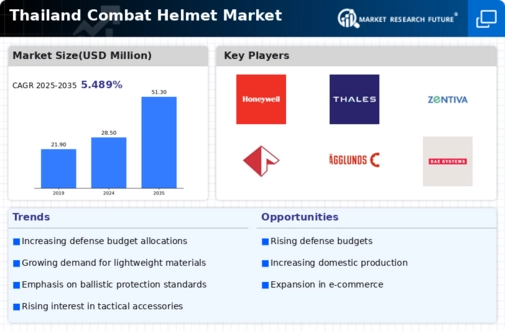The combat helmet market in Thailand is characterized by a competitive landscape that is increasingly shaped by innovation, strategic partnerships, and regional expansion. Key players such as Gentex Corporation (US), MSA Safety Incorporated (US), and Revision Military Inc. (CA) are actively enhancing their market positions through various strategic initiatives. Gentex Corporation (US) focuses on advanced materials and technology integration, aiming to improve helmet performance and user comfort. MSA Safety Incorporated (US) emphasizes safety and compliance, leveraging its extensive experience in personal protective equipment to cater to military and law enforcement sectors. Meanwhile, Revision Military Inc. (CA) is known for its commitment to innovation, particularly in modular helmet systems that allow for customization based on mission requirements. Collectively, these strategies contribute to a dynamic competitive environment, where technological advancements and user-centric designs are paramount.
In terms of business tactics, companies are increasingly localizing manufacturing to reduce lead times and enhance supply chain efficiency. This approach not only mitigates risks associated with global supply chains but also aligns with regional demands for quicker delivery and customization. The market structure appears moderately fragmented, with several players vying for market share, yet the influence of major companies remains substantial. Their ability to innovate and adapt to changing market conditions is likely to dictate the competitive dynamics moving forward.
In October 2025, Gentex Corporation (US) announced a partnership with a leading Thai defense contractor to co-develop next-generation combat helmets tailored for the Southeast Asian market. This collaboration is strategically significant as it allows Gentex to leverage local expertise and insights, potentially enhancing product relevance and market penetration. Such partnerships may also facilitate compliance with regional regulations and standards, thereby strengthening Gentex's competitive position.
In September 2025, MSA Safety Incorporated (US) launched a new line of lightweight helmets designed specifically for urban operations, addressing the growing demand for mobility and protection in complex environments. This product introduction is indicative of MSA's strategic focus on innovation and responsiveness to market needs. By prioritizing lightweight materials and ergonomic designs, MSA aims to capture a larger share of the tactical helmet segment, which is increasingly sought after by military and law enforcement agencies.
In August 2025, Revision Military Inc. (CA) unveiled a new modular helmet system that incorporates advanced communication technologies. This development is particularly relevant as it aligns with the increasing integration of digital solutions in combat gear. The ability to seamlessly integrate communication devices into helmets not only enhances operational efficiency but also positions Revision as a leader in the evolving landscape of combat equipment. Such innovations are likely to attract attention from defense agencies looking for cutting-edge solutions.
As of November 2025, current trends in the combat helmet market reflect a shift towards digitalization, sustainability, and the integration of artificial intelligence. Strategic alliances are becoming increasingly important, as companies recognize the value of collaboration in driving innovation and enhancing product offerings. The competitive differentiation is expected to evolve, moving away from traditional price-based competition towards a focus on technological advancements, reliability in supply chains, and the ability to meet specific user needs. This transition underscores the importance of innovation and adaptability in maintaining a competitive edge in the market.

















Leave a Comment